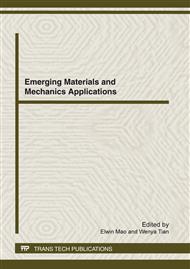p.53
p.58
p.64
p.69
p.74
p.81
p.89
p.94
p.99
Pilot-Scale Test on Ozone Pre-Oxidation for Enhanced Coagulation Treatment of the Micro-Polluted Reservoir Water
Abstract:
Pilot scale tests are conducted to study the pre-ozonation effect of the micro-polluted surface water and its influence on the operation and treatment effects of the follow-up filtration units. The results showed that significant improvement of sand filtration performance was achieved through the use of ozone pretreatment, and the filtration cycle was nearly doubled. The THMFP removal rates of the pre-ozonation technology and the conventional technology are respectively 32% and 18%, and the former one has reduced obviously the particle number of sand filtration effluents which implied the reduced probability of detection rates of effluent microorganisms and pathogens. Long-term run effect showed that the pre-ozonation process was superior to conventional processes in CODMn and turbidity removal.
Info:
Periodical:
Pages:
74-80
Citation:
Online since:
March 2012
Authors:
Keywords:
Price:
Сopyright:
© 2012 Trans Tech Publications Ltd. All Rights Reserved
Share:
Citation:


